2005 VOLKSWAGEN GOLF seats
[x] Cancel search: seatsPage 4 of 444
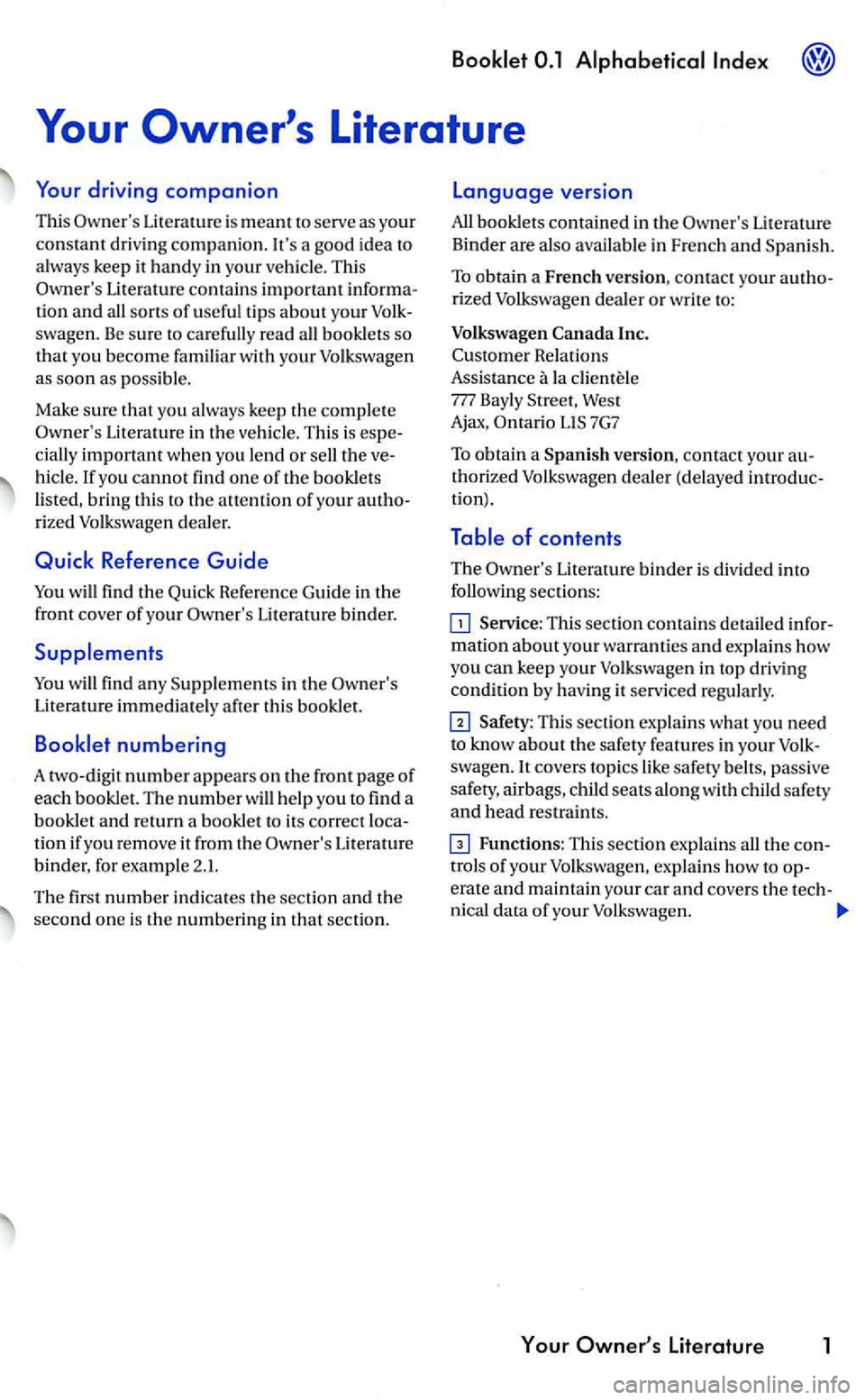
Your
a goo d idea to alway s keep it handy in your vehicle. This
Owner 's Literatur e contains important informa
t ion and all sorts of useful tip s abo ut your Volk
swage n. Be sur e to care full y rea d all bookle ts so
t hat yo u beco me familiar with your Volkswage n
a s soon as poss ible .
Ma ke s
ure that you always keep th e complete Owner's Literature in the ve hicle . T hi s is espe
cially important w hen you lend or sell the ve
hicle . you cannot find one of th e booklets lis ted, brin g thi s to the attent io n of your autho
r ize d Volkswagen dealer.
Quick Reference Guide
You find the Quick Reference Guid e in the
front cover of your Owner's Lite rature binde r.
You will find any Supplements in the Ow ner's Literature immediate ly afte r thi s booklet .
Ia cli ente le m Bayly W es t
A jax , Ontario 7G7
To obtain a versi on, contact your a u
thori zed Volkswagen dealer (d e layed introd uc
tion).
Service : This section contains detailed in for
mation about your warr anti es and explain s how you can keep your Volk s wa gen in top drivin g
co ndition by hav ing it serviced regularly.
covers topics like safe ty belt s, pass ive
safety, airb ags, child seats alo ng wit h child safety and head res tra ints .
Functio ns: This section exp lain s all th e con
trols of your Vol k swage n, ex pla in s how to op
erate and maint ain your car a nd cove rs th e tech-
nical data of your Volkswagen .
Page 7 of 444
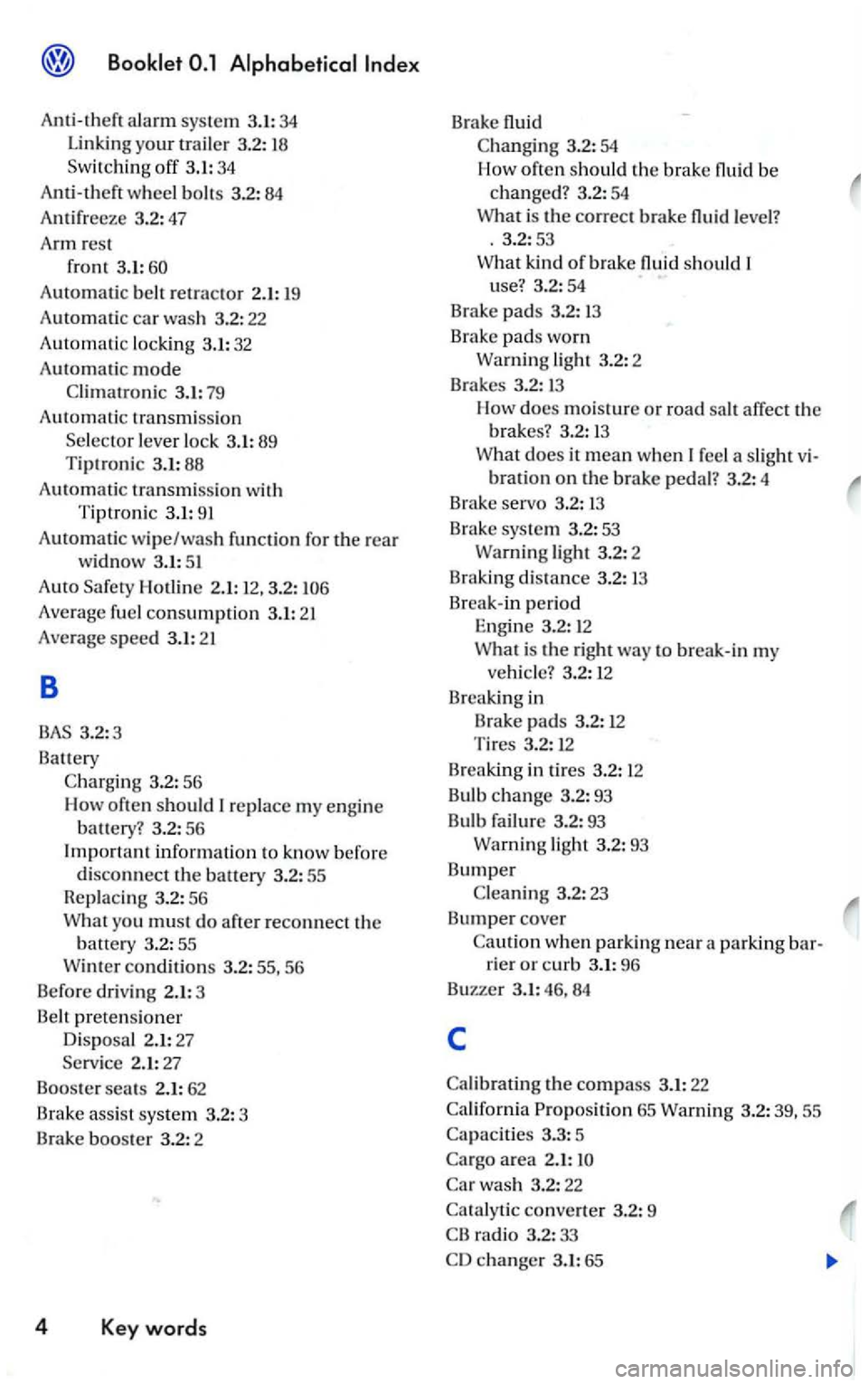
Anti-theft alarm system 3.1: 34
Linking your trailer 3.2: 18
Switching off 3.1: 34
Anti-theft wheel bolts 3.2: 84
Antifreeze 3.2:47
Arm rest
front
3.1:60
Automatic belt retractor 2.1: 19
Automatic car wash 3.2: 22
Automatic locking 3.1: 32
Automati c
mode
Climatronic 3.1: 79
Automatic transmi ssion
Selec tor lever lock 3.1: 89 Tiptronic 3.1: 88
Automatic transmiss io n with
Tiptron ic 3.1: 91
Automatic wipe/wash function for the rear
w idn ow 3.1: 51
Auto Hotline 2. 1: 12,3.2: 106
Average fuel consumption 3.1: 21
Average sp ee d 3.1:21
8
2.1: 27
Booster seats 2.1: 62
Brake assis t sys tem 3.2: 3
Brake boo
ster 3.2: 2
4 Key words
Brake
Changing 3.2: 54
level?
. 3.2:53
W hat kind of brak e
65 Warning 3.2: 39, 55
Capacities 3.3: 5
Ca rgo area 2.1:
Car wash 3.2: 22
Catalytic converter 3.2: 9
CB radio 3.2: 33
CD changer 3.1: 65
Page 10 of 444
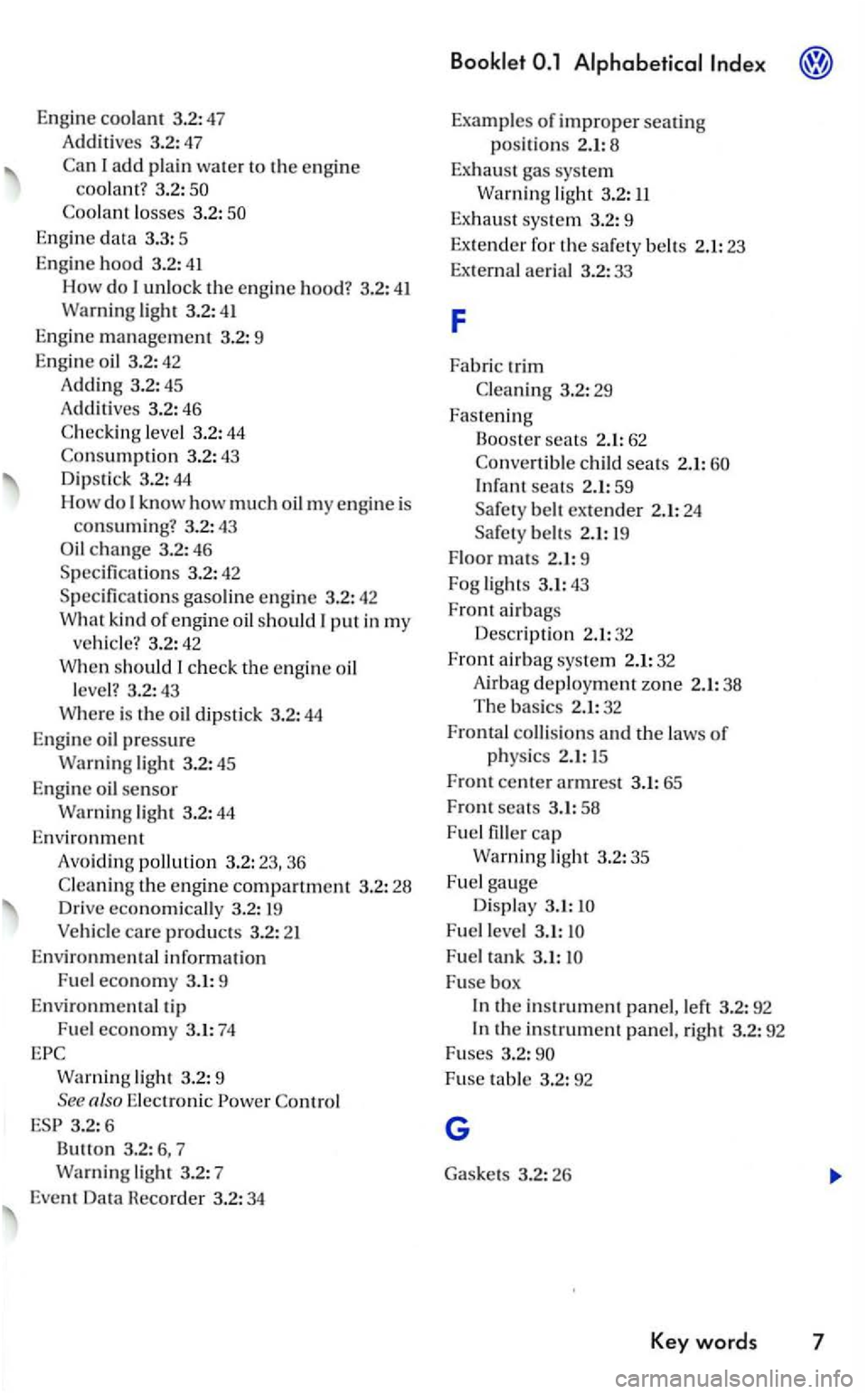
Engine coo lant 3.2:47
Add i
tive s 3.2:47
Ca n I
add plain water to the en gi ne coolant ? 3.2 :
Engine data 3.3: 5
Eng ine
hood 3.2: 41
How do unlock the engin e hood? 3.2: 41 Warn ing light 3.2: 41
Engin e management 3.2: 9
E ngin e oi l 3.2: 42
Adding 3.2: 45
Add itives 3.2: 46
Check ing leve l 3.2: 44
Consumption 3.2: 4 3
Dip s
tick 3.2: 44
How do know how much oil m y e ngine is
consuming ? 3.2: 43 c h an ge 3.2: 46
S p ecifica tion s 3.2: 42
Specificatio ns gaso line engine 3.2: 42
Wha t kind of e ngine oil should put in my ve hicle? 3.2: 42
When should check the e n gi ne oi l
l eve l? 3.2 : 4 3
Where is th e oil dip stick 3.2:
44
E ngin e oil pr essure
Warning light 3.2: 45
Eng ine oil
senso r
Warning light 3.2:
44
Environme nt
Avoidi ng pollution 3.2:23,36
C le
aning th e e ngin e compartment 3.2 : 28 Drive economicall y 3.2:
Warni ng ligh t 3.2: 9 also Elec tronic Co ntrol
3.2:6
B utt on 3.2 : 7
Warning
lig ht 3.2: 7
Even t Data Hecorder 3.2:
34
Examples of improper seating
position s 2.1:
Infant seats 2.1: 59
Sa fe ty belt ex te
nder 2.1: 24
Sa fet y belts 2.1:
F loor mat s 2.1: 9
Fog light s 3.1
:43
F r
ont ai rbags
De
scription 2.1:32
Front air b ag sys tem
2.1: 32
A irb ag deploym ent zone 2.1:38
Th e bas ics 2.1: 32
Fronta l
collisions and the laws of
physics
1 5
Fr
ont center armres t 3.1: 65
Front seats 3.1: 58
F u el
fille r cap
Warni ng light 3.2:35
Fuel ga uge
Displa y 3.1:
F ue l level 3.1:
Fuse box
th e in strume nt panel, left 3.2: 92 the instrument panel, rig ht 3.2: 92
Fu ses 3.2:
Page 13 of 444
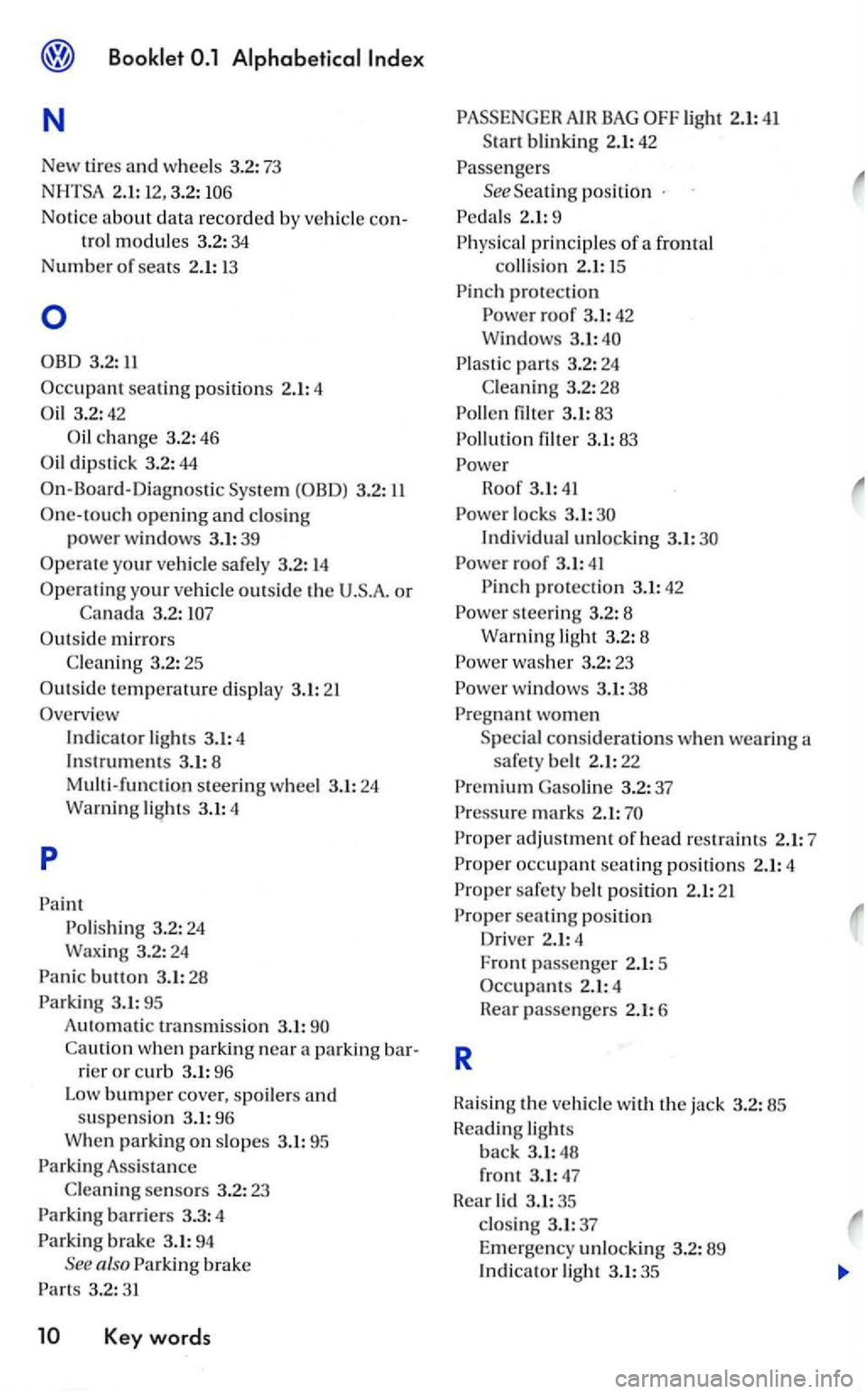
Booklet
N
New tir es and whe els 3.2: 73
tr ol m odules 3.2 : 34
N
umber o f seats 2.1: 1 3
Occ upa nt seatin g posit i o ns 2.1:4
3. 2:4 2
ch a nge 3.2: 46
dip stic k 3.2: 44
On-Boa rd-D iagnosti c (OBD) 3.2:
One-to uch openin g and closing
power
windows 3.1 :39
O p
erate yo ur ve hicle safe ly 3 .2: 14
O perat in g yo
ur veh icle out side th e or
Ca nad a 3 .2:
light s 3.1 : 4
Paint
Polishin g 3.2 : 24 3.2 : 24
Panic button 3.1: 28
Parkin g 3.1: 95
A ut om atic tra nsmi
ssion 3.1:
w hen parkin g ncar a p arkin g rie r or curb 3.1 : 96
L ow bum
per cover, s po ilers and susp en sio n 3.1: 96
also Parking b ra ke
Parts 3.2 : 3 1
K ey w ord s
ligh t 2.1:41
positio n
Ped als 2.1 : 9
P hysica l pr incip les of a f r
ontal
collisio n 2.1: 15
P i
nch pro tect io n
Power roof 3. 1:
42
P lastic parts 3 .2 : 24
C l
eaning 3.2: 28
Pollen filter 3.1:83
P ollu tio n filler 3.1:83
Power
Roof 3.1:4 1
Power locks 3.1 :
In d ividual unlockin g 3 .1 :
P owe r roof 3.1:41
Pinch protect io n 3.1: 42
Powe r s teerin g 3.2: 8
light 3.2 : 8
P o we r was her 3.2:
23
Powe r w ind ows 3.1: 38
Preg na nt wo men
co nside ra tions w hen wearing a
safety bell 2.1: 22
Pre miu m Gaso line 3.2 :37
Pr ess
ure mark s 2.1:
Pro per adju stment o f head res train ts 2.1: 7
P
roper occupant seat i n g positio ns 2.1: 4
Pro per
safe ty bell pos it io n 2.1:2 1
Prope r
posi tion
R
D river 2.1: 4
Fron t passenge r
2.1: 5
Occ upants 2.1:4
Rear passengers 2.
1:6
Rais in g th e ve hicl e w ith th e jack 3.2 : 85
H
eading lig ht s
back 3
.1:48
front 3.1: 47
Rear lid 3 .1 : 35
clos in g 3
.1: 37
Emerge ncy unloc kin g 3.
2:89 Ind icator light 3.1:35
Page 15 of 444
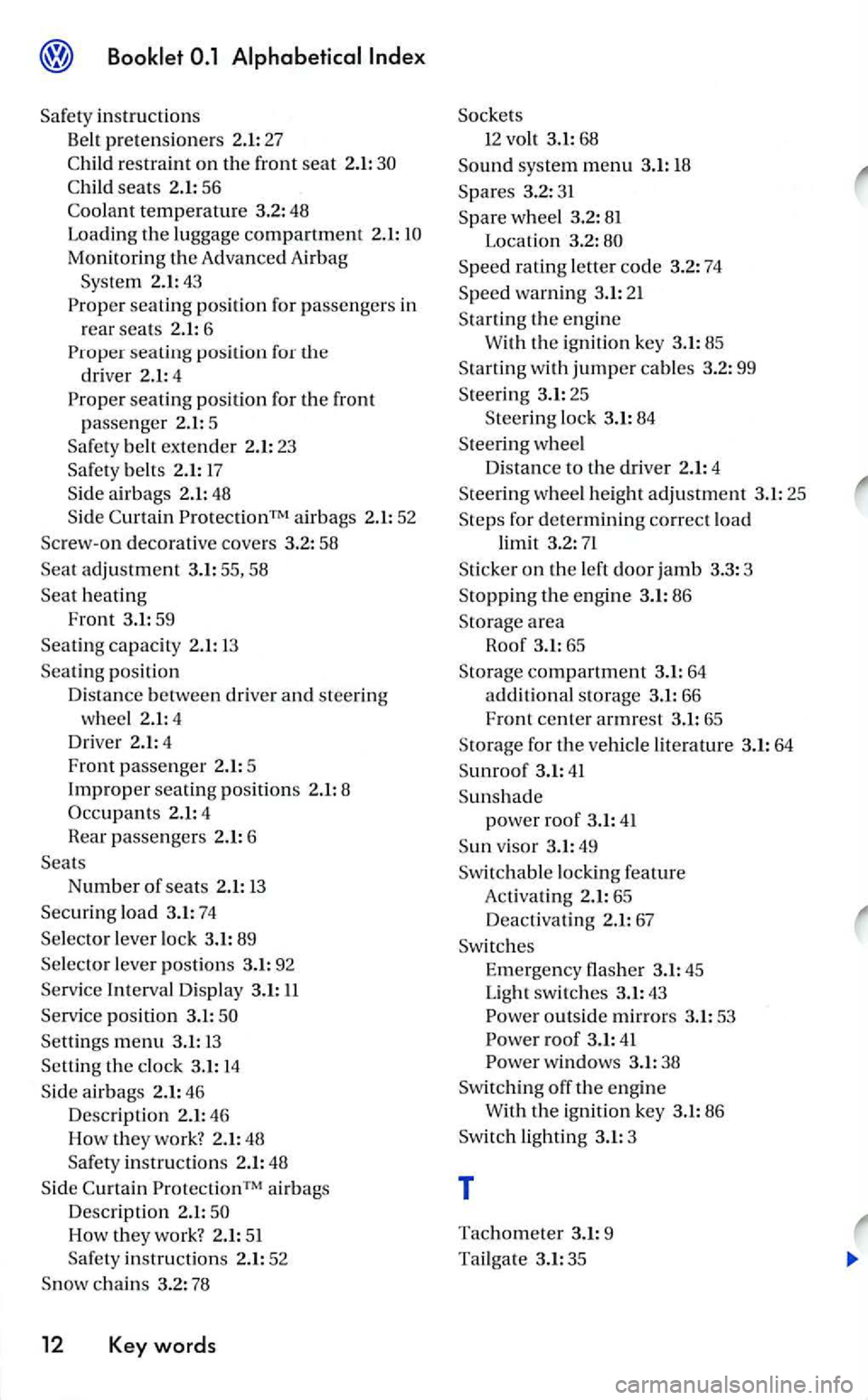
Safety instructions
Belt pretensioners 2.1: 27
Child restraint on the front seat 2.1:
Child seats 2.1 : 56
Coolant tempera ture 3.2:48
Loading
the lu ggage compartment 2.1:
seating position for passengers in
r
ear seat s 2.1: 6 seating position for
driver 2.1: 4
seating position for the front
passenger 2.1: 5
Safety belt extender 2.1: 23
Sa fet y
belts 2.1: 17 S id e airbag s 2.1: 48
Side Curtain ProtectionTM airbags 2.1: 52
Screw-on decorati ve covers 3.2: 58
Seat adjustment 3.1: 55, 58
Seat heating
Front 3.1:
59
Seating ca pacity 2.1: 13
Sea ting
position
Di s
tance between driver and ste erin g
w
hee l 2.1:4 Dr iver 2.1: 4
Fron t passen ger 2.1: 5 Improper seatin g position s 2.1: 8
Speed rating le tter code 3.2: 74
Speed warning 3.1: 21
Starting th e engine W ith the ig nition key 3.1:85
S tartin g
with jumper cables 3.2: 99
Stee rin g 3.1: 25
S
teering lock 3.1: 84
S te ering
wheel
Di s
tance to the driver 2.1: 4
Steerin g wheel height adjustment 3.1: 25
S
teps for determining co rrect load limit 3.2: 71
Sticker on th e left door jamb 3.3 : 3
Stopping the en gine 3.1:8 6
Sto rage
area
Roof 3.1:65
S torage
compartment 3.1: 64
additional sto rage 3.1: 66
Front center armrest 3.1: 65
S torage for
the vehicle literature 3.1: 64
Sunroof 3.1: 41
Sunshade
power roof 3.1:41
Sun viso r 3.1:49
Sw itch
able loc king feature
Activatin g 2.1: 65
D
eacti va tin g 2.1: 67
Sw itches Em ergency flasher 3.1: 45
Light swit ches 3.1: 43 outside mirrors 3.1: 53 ro of 3.1:41 windows 3.1: 38
Sw itching off the engin e
W ith the ignit ion key 3.1: 86
Sw itch
lig htin g 3.1: 3
T
Tachometer 3.1: 9
Ta
ilga te 3.1:35
Page 89 of 444
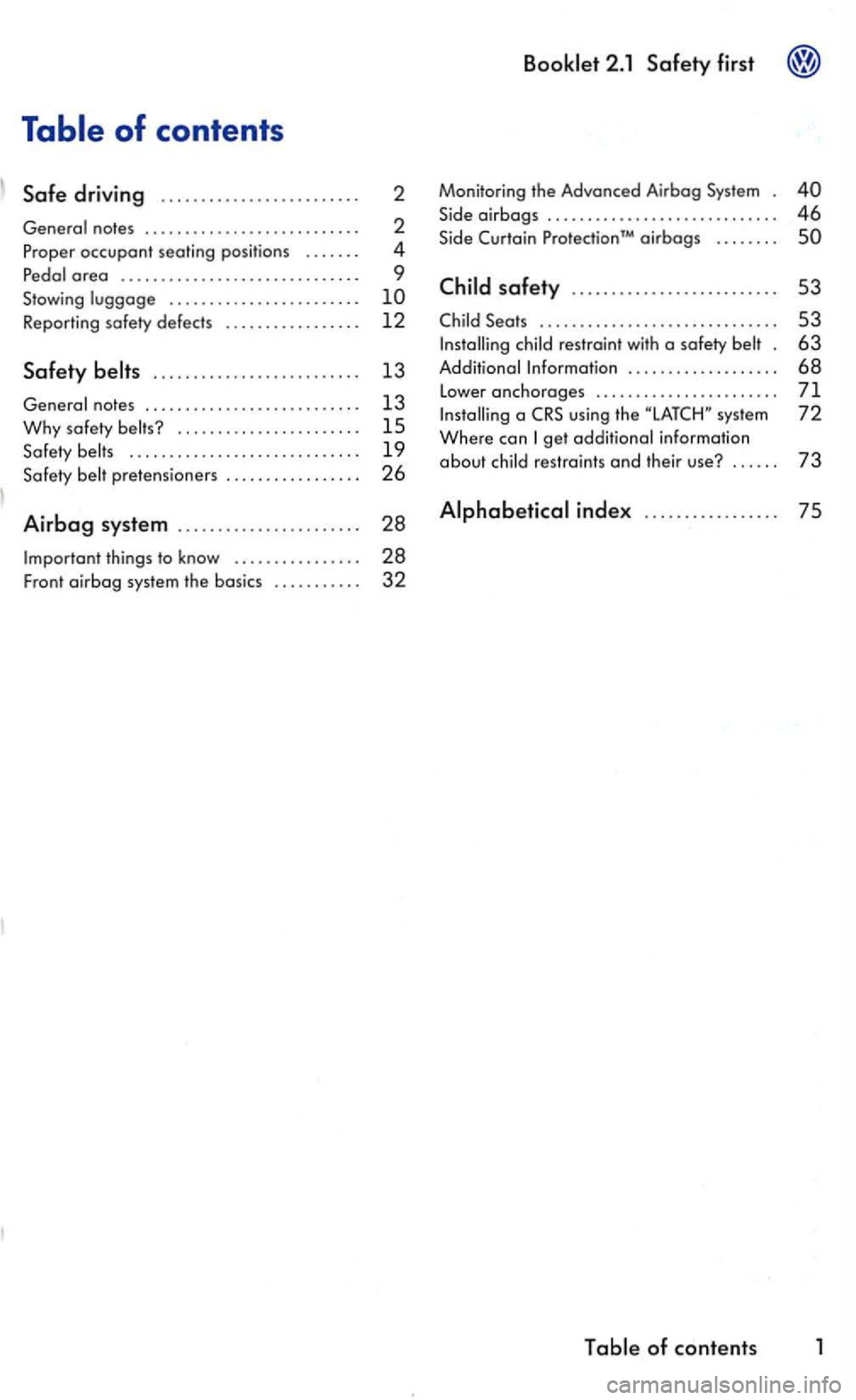
driving ........................ .
occupant seating positions ...... .
a reo ..............................
Stowing ....................... .
Reporting safety defects
............... . .
......................... .
notes ....................... ... .
Why safety ...................... .
Saf ety .................
Safety pretensioners ................ .
Airbag system
28
Front airbog system the basics ..... 32
Boo klet 2.1 first
Monitoring the Advanced Airbog System
46 Side
safety 53
Seats ...... ........... .. 53 restraint with o safety . 63
Inform ation 0................. 68
Lower anchorages .......... .... 7 1 system 72
Where con get additional inform ation
a bout
res traints and their use? . . . . . . 73
Alphabetical index ....
Page 90 of 444
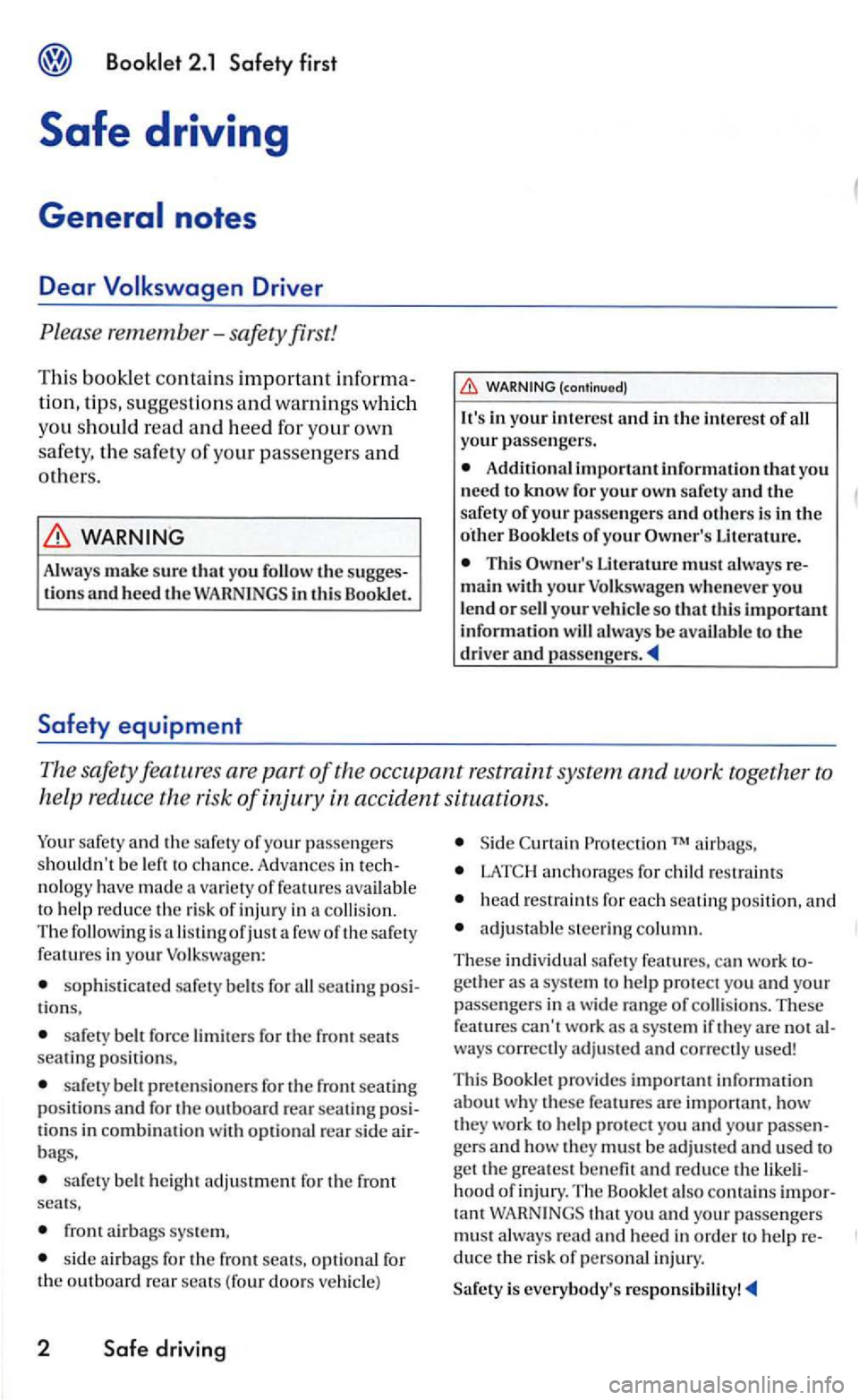
WARNING
Always make sure that you the suggestions and heed th e WARN INGS in this Booklet.
Safety equipment
Additional important information that yo u
need to know fo r you r own safety and the safety of your passengers and others is in the Bookl ets of your Literature.
T his
The safety are part of the occupan t rest rain t system and work together to
help reduce the risk
of injury in accident situation s.
Your safe ty and the safety of your pass enge rs
s houldn 't be left t o chance. Adva n ces in te ch
n ology have mad e variety of feature s available to help red uce the risk of injury in a collisio n.
T he followin g is lis tingofjust a few of th e s afe ty
f e at ures in your Vo lk sw age n:
sophisticate d safe ty belt s for all seating positio n s.
sa fe ty belt force for the front seats
s eati ng po sition s,
safety be lt pre te nsioners for the front seatin g
p ositions and for the outboard rear seating pos i
t io ns in combin ati o n w it h optional re a r s id e air
b ags,
sa fety b elt he ight adjustment for the front s eat s,
fr ont airbags sys te m ,
sid e airb ags for the front seats, optiona l for the outboard re a r seats ( fo u r doors ve hicl e)
2 Safe driving
S id e Protection ai rbags,
h ead res tra in ts fo r ea ch seat in g positi on , and
adjustable s teerin g column.
T he se
individua l sa fety features, wo rk t ogeth er as a syste m to help protect yo u and your passeng ers in a wid e range of collis io ns. T hese features can't work as a sys te m if they are notal
w ays correctJy a dju ste d and correc tl y used!
T
his Bookle t p rov ides important in for matio n
a b out why these features are important, how they w ork to help protect yo u and your passengers and the y m ust be adju ste d and used to get the g re atest ben efit an d reduce the lik eli
h oo d of injury. T he Booklet a ls o conta in s i mpo r
t a nt WARNINGS th a t yo u a nd you r passenge rs mus t alw ays rea d and hee d in order to he lp r e
d uce th e risk o f perso nal inju ry.
Safety is
everybody' s responsibility!
Page 93 of 444
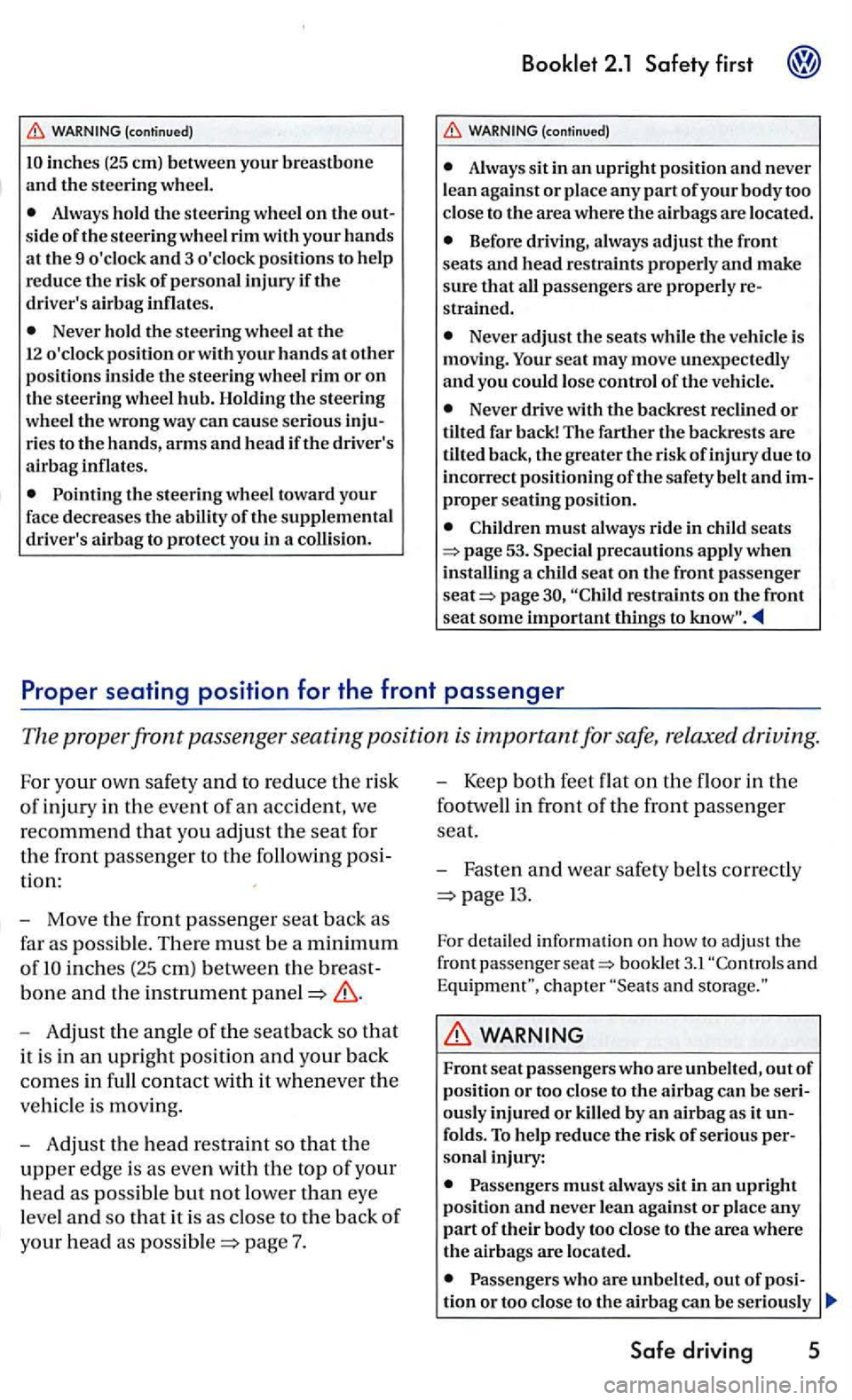
inches (25 em) between your breastbone and the steering wheel.
Always hold the s teering wheel on the
Never hold the steering wheel at the 12 o'clock position or with your hands at other positions inside the steering wheel rim or on the steering wheel hub. Holding the steering
wheel the wrong way can cause serious
2.1 Safety first
(continued)
Always sit in an upright posit i on and never lean against or place any part of your body too
close to the area where the airbags are located.
strained.
Never adjust the seats the vehicl e is mov ing. Your seat may move unexpecte dly and yo u could lose control of the vehicle.
Never drive wit11 the backrest reclined or tilted far back! The fart her t11e backrests are tilted back, the greater the risk of injury due to
incorrect positionin g ofthe safety belt and
Children must always ride in child seats
page restraints on t11e front seat some important things to
Move the front passenger seat back as
far as possible. There must be a minimum
of
Adjust th e angle of the seat back so that
it is in an upright position and your back
comes in full contact with it whenever the
veh icle is moving.
Adjust the head restra int so that the
upper edge is as eve n with the top of your
h
ead as poss ible but not lower than eye
leve l
and so that it is as close to the back of
your head as
Keep both feet flat on the floor in the
footwell in fron t
of the front passenger
seat.
Fasten and wea r safety belt s co rrectly
13.
For detail ed inform ation on how to adju st the
front passenger bookl et 3.1 and s torage.""
WARNING
Front seat passengers who are unbelted, out of posit ion or too close to the airbag can be
risk of serious
Passengers must always sit in an upright position and nev er lean against or place any part of their body too clos e to the area where the airbags are located.
Passengers who are u nbelted, out
Safe driving 5